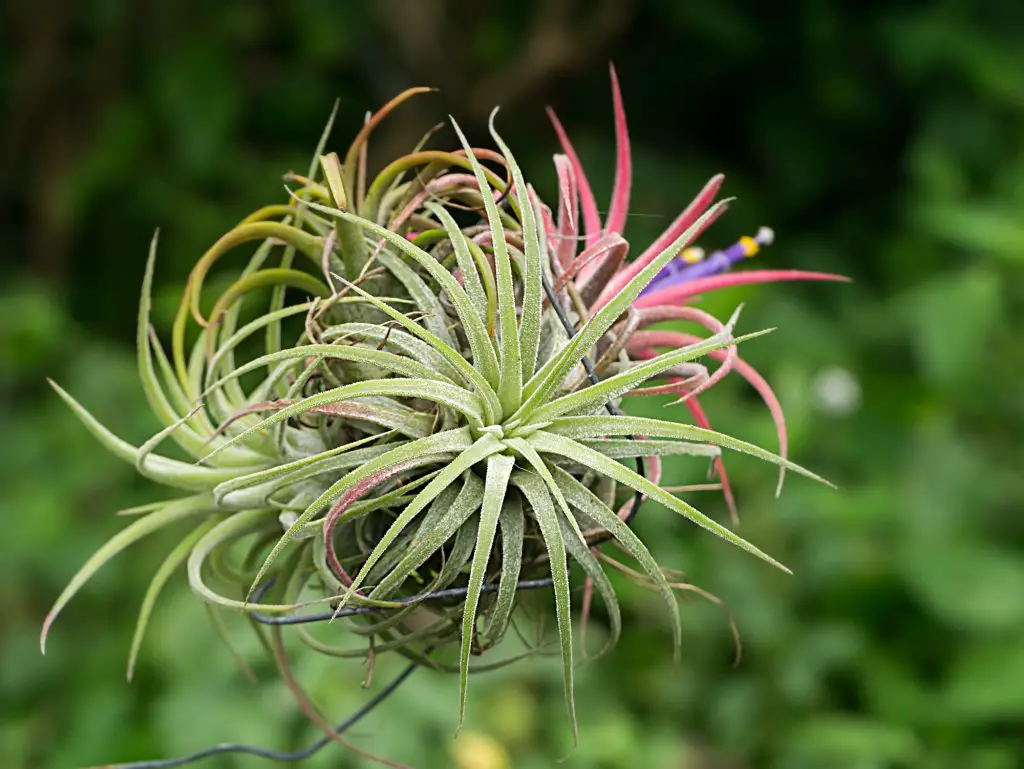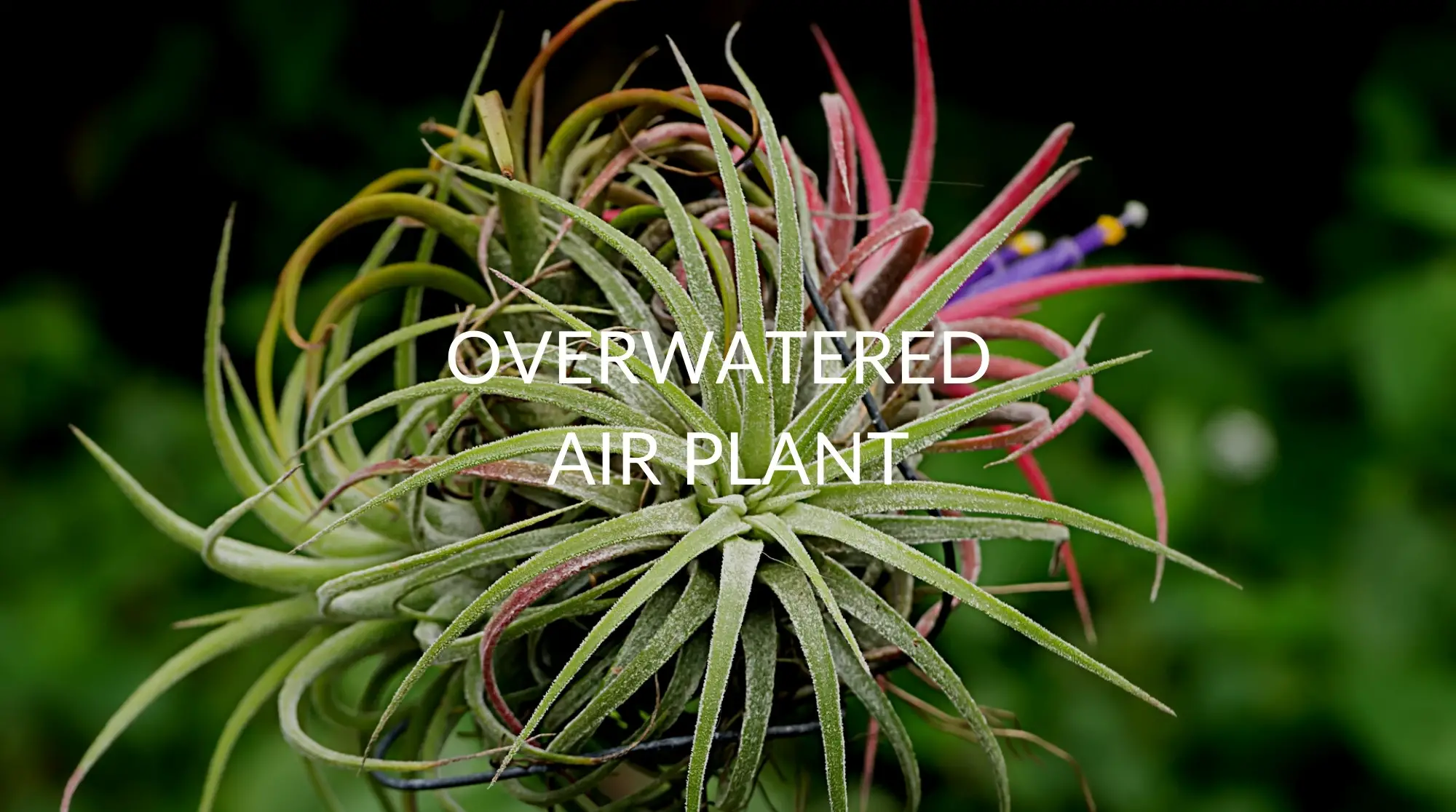Surprisingly, overwatering kills more air plants than under-watering. If the bottom of your Tillandsia appears dark and slime, it has been overwatered. Instead of dipping or bathing your air plant in a bath, consider watering it with a spray bottle to avoid overwatering. To prevent overwatering, make sure your air plant is completely dry between watering.
Continue reading to discover more about overwatering an air plant, the telltale signs your air plant has been given too much water, how to save an overwatered air plant, and more.
Can You Overwater an Air Plant?
An air plant may be overwatered, but not in the way you might assume. An “overwatered” air plant did not get excessive water. Rather, it has not been thoroughly dried out. Rot is indicated by purple or black at the plant’s base. This necessitates a modification in the way you water your air plants.
When you overwater an air plant, the leaves are effectively drowned. This can result in leaf rot or fungal infections.
How Can I Tell if My Air Plant Is Overwatered?
An air plant will become brown if it is overwatered. The plant’s base darkens and gets sticky, as you can see. Other portions of the leaves may have brown or black stains. Lower leaves will begin to fall off one by one, revealing the plant’s center. Yellowing leaves are typical, and the entire air plant will eventually come apart.
Your Tillandsia is considered healthy if its leaves are green and lush. Black spots, dark bases, and brown leaf tips suggest illness. Leaves that are yellow, wrinkled, or curled in the center are not suitable. Take note that air plants only produce flowers when they’re in optimum condition; therefore, if you notice new blossoms, congratulate yourself on the care of your Tillandsia.
The Leaves of Your Air Plant Have Turned Yellow
A dark tint creeping up from the plant’s base into the leaves is the first sign of a decaying air plant. The brilliant color of an air plant that has succumbed to root rot begins to fade. If nothing is done, their green colors will weaken and eventually fade away, leaving them colorless before they die.
Dark or Black Patches Appear on the Air Plant
Excessive watering can cause internal or external decay in air plants. If damp black patches appear on the leaves or the base of your Tillandsia, it is time to replace it. Without prompt identification, the rot can and will spread to the plant’s interior, causing it to disintegrate and die.
Your Air Plant’s Texture Has Changed
Air plants are supposed to be sharp and rigid plants. If your Tillandsia begins to feel spongy or squishy, your air plant may be suffering from overwatering or root rot.
Your Air Plant’s Leaves Fall Off
When an air plant is overwatered and root rot germs take hold, the base leaves of your air plant may discolor before dying off. If the base leaves of your air plant appear to be darkening, act quickly to eradicate the rot before the plant loses too many leaves or dies.

What Happens When You Overwater an Air Plant?
Overwatering an Air Plant Can Lead to Fungal Issues
You have been overwatering your air plant if the fungus appears on it. Fungus is usually a sign that there is moisture in your air plant. If you’ve been overwatering your air plants, you’ve created the ideal environment for fungus to flourish. The leaves become black due to fungus diseases. They will eventually fall off.
In most situations, the fungus will grow owing to insufficient ventilation. If a fungus is present, the air plant’s leaves will begin to look stale, lose their luster, and fall off. The fungus is also present if the plant appears brown or feels mushy. Ensure there’s no excess water hanging around in the plant’s crevices to prevent fungus growth.
Overwatering an Air Plant Can Cause Rot Issues
An overwatered, rotted air plant’s root might be spongy and mushy, with a brown appearance. Leaves at the plant’s base also fall off, which is a symptom of interior rot. In the worst-case scenario, the facility will collapse. Inner rot is typically difficult to detect until the plant suddenly falls apart.
Take note that changes in the colors of an air plant leaves are typically the first indication of illness. Leaves that are becoming yellow, as well as leaves that are growing mushy to the touch, can indicate signs of overwatering or rot.
When leaf root develops on the outer leaves, it is simpler to see. Remove any affected leaves from around the plant and at the base if these black spots appear to prevent spreading. You should clean up and remove any leaves that came into contact with the diseased leaf.
Can You Revive an Overwatered Air Plant?
You may rejuvenate your air plant by carefully plucking the brown or black leaves as soon as you notice them to prevent the illness from spreading. To avoid root rot, keep the air plant in a well-ventilated area and allow it to dry immediately after watering.
Severe occurrences of root rot that extend to the plant’s center might cause the air plant to die. If the root rot is powerful enough that the plant begins to come apart, you’ll need to start over with a new plant.
How To Save Your Overwatered Air Plant
Early Detection of Overwatering
Catching the signs of an overwatered air plant early can help in the overall rejuvenation process. You can keep your air plant happy and healthy by paying particular attention to its watering schedule, light, air circulation, and fertilizer. While watering the plant, keep an eye out for signs of overwatering like color changes, a soft feeling, or visible rotting.
Trim The Damage to Your Air Plant
Taking away any dead leaves from an air plant that has begun to deteriorate is a simple and natural technique to keep it alive. Allowing your air plant to cling to damaged or dead leaves may obstruct air movement and sunlight absorption.
When dead leaves are removed, newer, stronger leaves sprout in their place. This is important since air plants rely on their surroundings for nutrients and moisture. Removing the dead leaves may be all that is necessary to resurrect the plant.
If picking at the dead leaves causes the entire plant to split apart, you’re in for some bad news. If this occurs, it is possible that your air plant has already died. The secret to reviving the plant is to look for green, healthy leaves. If there aren’t any, the air plant will very certainly have to be scrapped.
Using Natural Substances Like Cinnamon to Treat Overwatering in Air Plants
Cinnamon is a natural fungicide that can aid in the prevention of disease spread caused by overwatering. After you’ve finished the previous treatments and dried the plant, sprinkle cinnamon powder over the damaged areas. Continue in this manner every day until the deterioration is complete.
In the event that the condition recurs, another alternative is to dilute the water with cinnamon essential oil and use it to water the air plant.
How To Prevent Overwatering Your Air Plant
Avoid Soaking Your Air Plants for Extended Periods of Time
Stick to a regular watering schedule to avoid overwatering. Remember that, unlike many other house plants, Tillandsias absorb moisture through their leaves and trichomes rather than their roots and that overwatering can cause root rot.
Ensure the entire air plant is submerged in water when you soak it. Trichomes are strange plant cells found on the surface of air plants. These trichomes help air plants collect water through their surface. Consequently, instead of merely watering the root area, be sure to hydrate the entire air plant. It’s preferable to only soak for 30 minutes maximum to avoid root rot.
It is preferable to just immerse an air plant for a few minutes at a time. Some air plants should not be immersed in water, especially if you live in a humid region. Also, if your air plant is still damp, do not re-display it until it is completely dry.
Using Rainwater or Unchlorinated Water to Water Your Air Plants
Never water your air plants with distilled water. Due to the sheer salt content, softened water is also not a viable option. Filtered water or tap water that has been sat long enough for the chlorine to disperse and bottled water are all acceptable options. Pond water and aquarium water both work nicely as long as there aren’t too many fish or reptiles in them.
It’s preferable to use rainwater or unchlorinated water, especially if the tips of the air plant’s leaves have begun to turn brown. If you’re not giving them chlorinated water, but the leaves are still going brown, likely, your air plant isn’t receiving enough water.
Remove All Excess Moisture from Your Air Plant After Watering
After watering, brush or shake off any excess water and dry your air plants on some layered paper towels before returning it to your terrarium, shell, or anywhere else you’ve placed it. If you allow water to linger on the leaves of your air plant, the plant can eventually be harmed.
Never allow your air plant to sit in any accumulated water, as this will almost certainly result in root rot or the death of the plant.
Providing Your Air Plant with Adequate Lighting
Air plants require strong, indirect light to grow. Since the plant will be continually engaged in photosynthesis and absorbing the water molecules in the plant, providing appropriate sunlight for your air plant can also assist in preventing overwatering.
As a general rule, the more light the air plant can endure, the higher the humidity in your environment. This implies that if you’re going to put your air plant somewhere where it’ll get a lot of light, you’ll need to spray it more frequently.
Recap
Air plant maintenance is simple, but there are some guidelines to follow. They, like any other plant, can become unwell if they are not given enough or too much water, air, or sunlight. Rot is a frequent air plant disease that arises as a result of overwatering and is difficult to treat.
However, paying attention to these little plants can help you spot any illness early on, increasing the likelihood that treatment will be successful. If your air plant shows indications of overwatering, identify it immediately, remove any dead or rotting leaves, and treat it with cinnamon.

